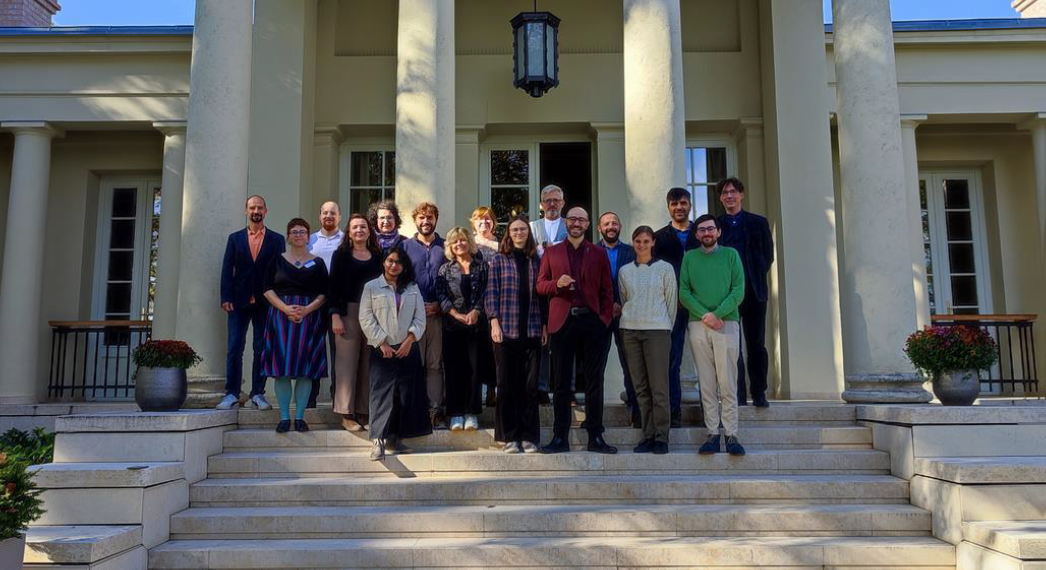
EoR Group photo
Working Group on Ethnology of Religion
The WG reports on the conference “Religious Art and Power - Contestations and Affirmations”, held in Budapest, Hungary on October 17th-19th, 2024.
Religious Art and Power - Contestations and Affirmations
From October 17-19, 2024, on the invitation of the Working Group Ethnology of Religion and the Hungarian Academy of Arts’ Research Institute of Art Theory and Methodology, Religious Scholars, Ethnologists, Art Historians, Artists, and Cultural Anthropologists from various European countries and India met at the beautiful Villa Hild in Budapest to discuss the topics of religious art, ritual, power, society and authority.
On Thursday, we started with the panel Theoretical Insights, in which we talked about the role of the Holy Fool in political contexts, who, as a social outsider, can play a special role in internal criticism (Ákos Windhager). Thorsten Wettich introduced us to the concept of ambiguity tolerance-intolerance, and Laura Iancu reported on the power of metaphorical language in verbal art. This theoretical foundation provided an excellent basis for hearing about different art forms with religious and power-political references in practice.
László Koppány Csáji introduced his case studies on three New Religious Movements in Hungary and Romania and explained how their members communicate in the digital space using, for example, caricatures and memes. Also, in the session on New Religious Movements, Márk Nemes elaborated upon the case study of his field research among the Damanhur community in Piedmont, Italy, encompassing impressive photographs of Damanhur’s colorful Underground Temple. The panel was rounded off by a contribution from Accursio Graffeo, who dealt with religious movements and AI in his paper and posed the question of whether machines are capable of developing (religious) autonomy.
There were two sessions on Ritual Arts and Performative Practices, in which Alfonsina Bellio told us about the fascinating phenomenon of the Pupazze in Calabria, Italy: a unique Palm Sunday procession that caused some controversy with the local Catholic Church. Kamila Baraniecka-Olszewska gave a historical insight with a critical classification on the occasion of the 900th anniversary of the Christianization of Pomerania by St. Otto of Bamberg. Finally, Vidisha Bagul presented interim results from her field research on a festival in honor of the Khandoba deity in Jejuri, India, and explained the complex interplay of performative choreography, pilgrimage, and devotees who allow themselves to be put into a trance.
An insight into musical practice in connection with Macedonian chain dance was given by Anna Mária Bólya, who reported on how dance is used as a metaphor in the past and today. The session was rounded off by István Povedák’s talk on The Politics of the ‘Roma Pilgrimage’ of Csatka and Zoltan Körösvölgyi, who took us into his research on the role of religious art during the political protests in Venezuela in 2017.
On Saturday, the conference participants gathered for the fifth panel to hear from Kinga Povedák on the powerful influence of Christian pop music in Hungary and to be taken on field research by Mario Katic on the burial ritual of Mirila in the Dalmatian hinterland of Croatia.
Last but not least, we heard two excellent presentations in the Sensory Religion session, which told us about the synagogue in Szeged. Dóra Pataricza and Ágnes Ivett Oszkó gave exciting insights about its unique architecture and history. Finally, Clara Saraiva's presentation focused on murals in the Vale de Amoreira, Lisbon, and how they help the local migrant community deal with the topics of death and grief.
After each of the six panels, there was room for questions, answers, thoughts, and comments. In addition, a newly formed research group of Alessandro Testa, Tobias Köllner, and Eva-Maria Fechtner presented their upcoming project on the topic of Religion and Power in a roundtable. This was followed by a book launch session, which showed new works recently published by the conference participants.
The academic part of the conference was perfectly complemented by the extracurricular activities, where many new contacts were made and experiences exchanged – and not to mention the excursion on Saturday to the Haré Krishna (ISKCON) temple in Csillaghegy, Budapest. Several members of the community gave the group a guided tour and exciting insights into the educational facilities, the huge kitchen where thousands of meals are prepared for the needy every day, as well as the ashram and the temple. They played some traditional music for the group and invited us to sing along and participate as well. Finally, we were served a delicious vegan meal of homemade Indian food and got to talk to some members of the community. We felt very welcome at this place and had such an exciting afternoon!
The conference made a valuable contribution to the fact that we, as Cultural Anthropologists, were able to exchange views on current debates and developments and give and receive new impulses. We would like to thank the team of the Hungarian Academy of Arts’ Research Institute of Art Theory and Methodology and the SIEF Ethnology of Religion Working Group for their excellent organization and hospitality. Special thanks to Márk Nemes and László Koppány Csáji. The Working Group was able to gather new members and is very much looking forward to the next WG-panel at the upcoming SIEF conference in Aberdeen.
You can find a link to the call of the conference here.
Luisa Köhler
University of Bremen





